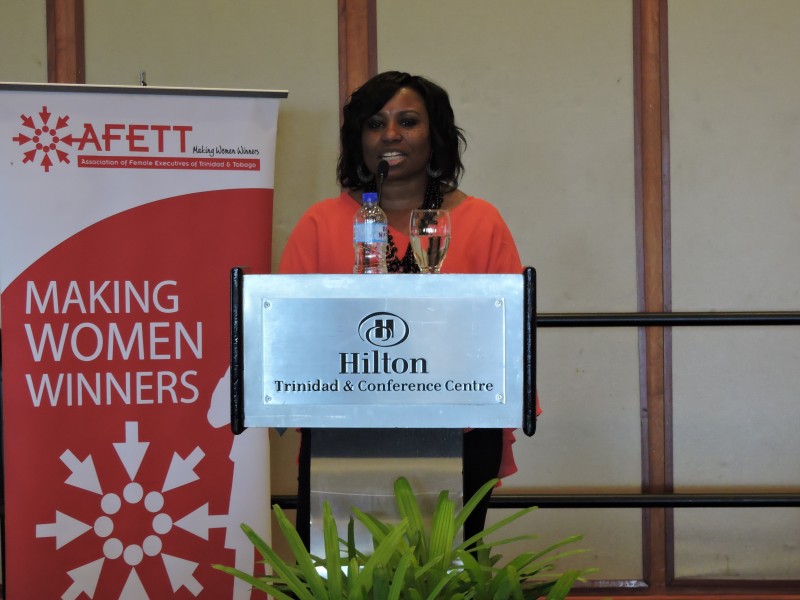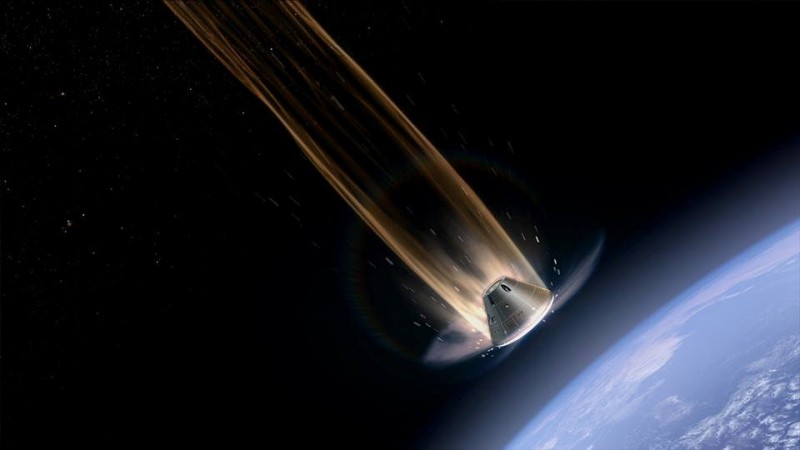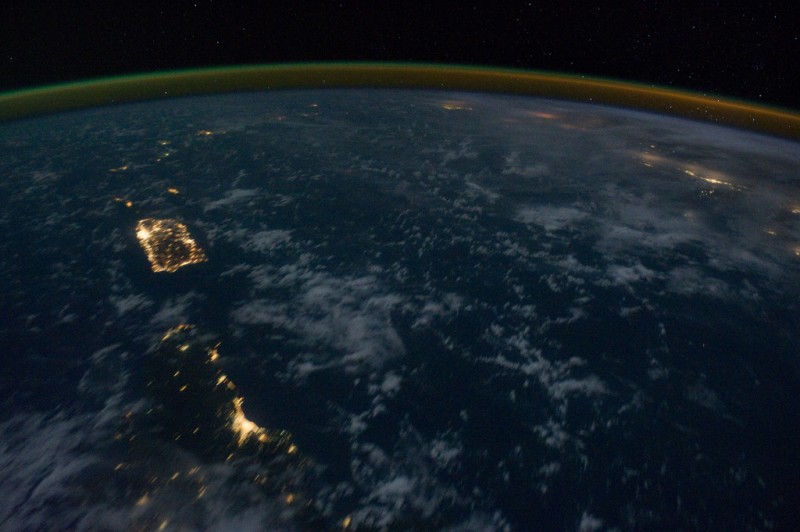
Camille Alleyne, NASA International Space Station Program Science Office; photo by Jared, used under a CC BY-NC 2.0 license.
The Association of Female Executives of Trinidad and Tobago (AFETT), of which — full disclosure — I am a past president, invited me to attend their annual International Women's Day luncheon earlier this week in Port of Spain.
The non-profit organisation acts as a networking hub for professional women, but has historically also done a great deal of social outreach, particularly in the area of creating educational and mentorship opportunities for young women. In keeping with this mission, AFETT's theme for this year's event was Inspiring, Educating and Motivating Women and Girls to Achieve their Full Potential, and the event's featured speaker, Dr. Camille Wardrop Alleyne, managed to do just that.
Wardrop Alleyne isn't just smart. She's a rocket scientist (well, Aerospace Engineer is her official title, but she has spent her 20-year career advancing the areas of aerospace and space technology development, particularly in human space flight). She was involved in three of the four NASA-led efforts at human space exploration, but her most recent passions lie in the application of space technology in international development and global science and space education for girls.
To this end, she founded the Millennia Global Development Group, an international development firm that finds space, science and technology-based solutions to economic development challenges in the Global South, as well as the Brightest Stars Foundation — a non-governmental organisation focused on the empowerment of young women around the world through education, particularly in the disciplines of science, math and technology.
In her address, Dr. Wardrop-Alleyne talked about everything from her childhood in Trinidad, where she would gaze up at the night sky from the bonnet of her father's car and spend hours on end building things, to her dream that by 2030, women the world over will understand they have a voice and use that voice for the betterment of humanity. I sat down with her to talk about her job, her gender and the difference she wants to make in the world.

Dr. Camille Wardop-Alleyne, addressing the audience at the Association of Female Executives of Trinidad and Tobago's 2015 International Women's Day luncheon. Photo by Dawn Lafond, used with permission.
Global Voices (GV): In three out of NASA's four human-manned space missions, you were an integral part of the team. Tell us about that.
Camille Wardrop-Alleyne (CWA): NASA has developed three human space programs from scratch and the fourth is in development. Human space programs are programs that involve the transport of humans (astronauts) to space versus robotics programs or satellites.
The first one was the Apollo program which sent astronauts to the moon in the late 1960s-1973.
Then there was the Space Shuttle program that was first flown in 1981-2010. The astronauts took seven to fourteen-day trips to Low Earth Orbit (LEO) and transported modules and other parts of the International Space Station (ISS), which is the third. The ISS is an orbiting science lab that has a crew of six that live and work for six months at a time. Assembly started in 1998 and ended in 2010. Then the lab was fully open for business and will be operational at least through 2024.
The fourth is the Orion which is the next generation spacecraft to take humans beyond LEO. It's in development and won't have first capability before 2018.
I have worked on the Space Shuttle program, the Orion program and the ISS for the last five years.
GV: You said your life changed when the Challenger exploded. What shifted for you in that moment?
CWA: I didn't know about space. I look back and I discovered that[studying space] was what I was doing when I used to lie on the bonnet of my dad's car and stargaze, but I didn't recognize it at the time. Even as a teenager, when I decided I was going to study engineering because I was good in math and science and we had a family friend who was a petroleum engineer, I didn't know. But I also had this love for planes, because we travelled a lot, from the time I was five years old. Plus, I always wanted to do something nobody else did, because I wanted to push the boundaries. I'm driven and really ambitious that way, and so I picked aeronautical engineering;which had nothing to do with space for me…until that day [the Challenger exploded]. It just opened up my mind.
GV: That's incredible – to have the Challenger fail so tragically and you end up designing shuttles that send humans into space. Is that scary? Putting people in them and saying, “God, I hope this works”?
CWA: The primary responsibility of NASA is safety when we're flying humans in space, so we have a lot of processes and procedures to go through. When the Challenger happened and subsequently the Columbia, it shut things down because all processes had to be re-evaluated. I remember starting to work at Kennedy Space Center, which is the launch facility for NASA, and so I started my career working with people who had been a part of Challenger, and looking at the launches still freaks them out because these people are your friends!
GV: Your parents created a supportive environment for you to thrive. They allowed you to tinker with anything that was broken around the house…what else did they do?
CWA: They stressed the value of education – that was the paramount thing. I've got to admit: We didn't get to do chores, I didn't learn to cook at an early age. All I was responsible for was keeping my room clean and studying. My mom was adamant that her girls [Alleyne is the youngest of three] were going to be independent and self-sufficient.
GV: You've obviously passed these traits on to your own daughter…
CWA: Yes, she's sixteen, she's amazing and she's getting ready to go off to college – to Yale University – in the fall, to study pre-medicine.
GV: How did you juggle marriage, a demanding career, parenthood..?
CWA: Oh my gosh…it was hard. It is about compromise and it is having a very supportive husband and family. I've been a single mom for five years now [Alleyne lost her husband in 2010] and it's just about trying to balance everything. I could have put all the travel aside, but it's important for me to show my daughter what she can do, what is possible for her – and the way I do that is by example.

Dr. Camille Wardrop-Alleyne poses with secondary school students in Trinidad. Photo by Dawn Lafond, used with permission.
GV: How do you think you've pushed the boundaries in your own career?
CWA: By what I represent being a woman of color, being a woman of color from a place other than the United States, and studying in a field that's so technically challenging. There are not a lot of rocket scientists…that in itself is a contribution and it serves as a beacon of light for many little ones coming up.
GV: Have there been any particular challenges that you think have come about as a result of the fact that you're different?
CWA: I think you're not given the benefit of the doubt right away. You've got to go 150% and even that is not enough. It is never enough, because it is not about that. It is about those inherent biases that exist that we can't control…so you just plough forward and prove yourself.
GV: What do you like best about your job?
CWA: What I love best is learning something new every day. The challenge…I love that! I'm not a scientist by trade, I'm an engineer, but I'm in a science job and the nature of the space station is such that we have taken that gravitational force out of the equation. The space station allows us to do that. Everything we know is under the influence of gravity, so we are learning an amazing amount about the most fundamental things. It's a multi-disciplinary lab and we do things like biology and bio-technology, human research. For example, how humans adapt to space is very much like the ageing process. They lose bone and muscle in the matter of a month that maybe a post-menopausal woman may lose in a year. So we have scientists and researchers whose job is to develop countermeasures to reverse that adaptation, so that we could one day send humans to Mars over a long duration of time. Whatever countermeasures are developed for astronauts could very much be translatable to a benefit on earth.

Orion reaching limits of Earth Atmosphere; photo by NASA's Marshall Space Flight Center, used under a CC BY-NC 2.0 license.
GV: Do you think we'll ever populate other planets?
CWA: It may not happen in my lifetime, but I think the generation of girls in that room will be the ones to develop those technologies that hopefully will allow us to go to Mars, where there's evidence of water and life at the smallest microbial level.
GV: Why do you believe education is so essential for both girls and boys and how can we stem the tide of rote learning that so many educational systems have fallen prey to, the Caribbean included?
CWA: I was a part of that system of rote learning, but I talk about education from a quality perspective, which includes inquiry-based learning, critical thinking and problem solving and really, the only way you get that is through the sciences. That is germane to those subjects. Something has to be done in transforming the education system, but it starts unfortunately with something like the Caribbean Examinations Council (CXC) saying, ‘No, we are going to value problem solving and critical thinking and project-based learning’ and then everybody will line up because they know that's what they're being tested on and that will transform the system.
GV: Tell us about the NGO you founded, the Brightest Stars Foundation.
CWA: I was sitting at headquarters one day, just looking around, not satisfied. I had accomplished a lot, but it was like there was something still burning inside me and it dawned on me that there were no little ones coming up behind me that looked like me. I know what space did for me — it pulled me outside of myself — and I wanted to give that back. It was a gift and I want to use my life, what I know, who I've become, for something greater than myself, and there's nothing greater than inspiring young minds. I wanted young people, especially people of color around the world, to be a part of that conversation about space, because it's so monolithic. The only way you can do that is through education. Ultimately, I want to build a school, a network of science academies for girls.

Eastern Caribbean at Night, taken from the International Space Station; photo by NASA's Marshall Space Flight Center, used under a CC BY-NC 2.0 license.
GV: You've worked out an interesting equation for making a positive impact on this world – can you share it with us?
CWA: Discovering your true calling + finding your voice + using your voice = reaching your full potential.
The first part of the equation happened for me when I decided that space exploration was what I wanted to study. Finding my voice followed when I came back from Kenya [on a volunteer trip called Under African Skies with Cosmos Education] and formed the non-profit, because I knew that empowering girls, educating girls, access to science and technology education was what my contribution was going to be. I used my voice when I found the courage to speak out and travel and advocate.
GV: So have you reached your full potential?
CWA: I'm living it. I think until we go six feet under we all are striving for that. I have a lot more that I need to do. I am very passionate about space technology for sustainable development. There are a lot of developing countries getting into the space business. When people think of space – especially here – they think about going to Mars. It's not about that; it's about looking back on our planet and using that technology to sustainably develop it and I want that in the Caribbean region.







1 comment